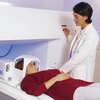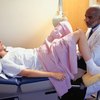A hernia is a rupture or weak spot in tissue that holds an organ in place. Advanced hernias can result in an organ working its way through the hole. They can take a long time to develop or can happen immediately after some kind of trauma. Either way, hernias must be identified and patients should have a doctor enlisted to fix them.
Examine your torso for bulges or swelling. If an organ has penetrated muscle, you may be able to see the little bump that results from this. Have someone check your back and anywhere else you can’t see on your own.
Press softly into your body to try to feel for a hernia. Anything out of the ordinary can be the manifestation of a hernia. Any bumps or soft anomalies could be an organ bulging through your muscles. Just as is the case with a visual check, have a friend check the hard-to-reach parts. Common places for hernias are inside belly buttons and in the groin area.
Consider the pain you are feeling, if you have any at all. Hernias can cause sharp and dull kinds of pain. Because you could have twisted organs, if the pain gets worse when you stand, the pain could be the result of your hernia. If you have additional pain when pressing on a suspected hernia, this could be further confirmation.
Engage in the dreaded kind of hernia check. While it may not be pleasant, diagnosing a hernia in the groin is something that should be done. You can check for a hernia in the groin by getting in an upright position. Press your fingers into the scrotal skin and press your finger against the pubic tubercule. You should be able to feel the inguinal ring. Apply stress, as though you were using the bathroom. If you feel anything out of place, this could be a hernia.
Look beneath the surface through the use of medical X-rays. Doctors can use X-rays to diagnose a hernia for you.




